Sunflower Seed Pesto
Sunflower Seed Pesto is a nut-free version of traditional pesto! Swap sunflower seeds for pine nuts in this simple 5-minute seed-based pesto recipe.
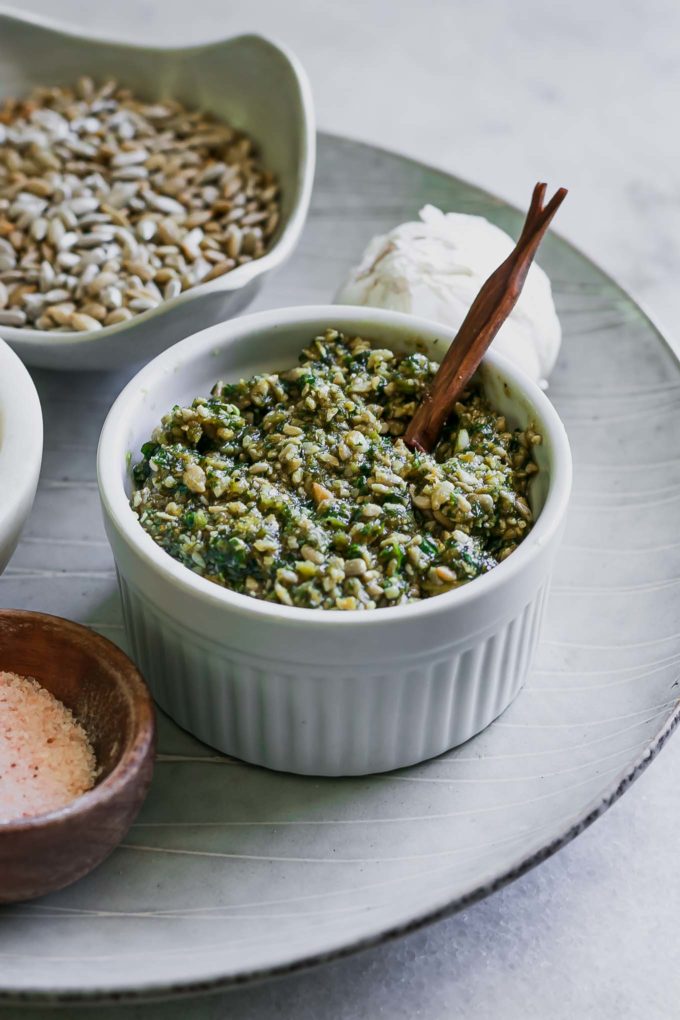
Want to Save This Recipe?
Enter your email & I’ll send it to your inbox. Plus, get new plant-based recipes in your inbox!
By submitting this form, you consent to receive emails from Fork in the Road.
Love pesto but suffer from a nut allergy? I feel you! As someone with a nut sensitivity, I’m not able to enjoy traditional pesto with pine nuts and instead have to come up with creative ways to add a bit of crunch to pesto — like using sunflower seeds.
👉 If you’ve never tried it, here’s why you should be making nut-free pesto with sunflower seeds:
- It’s delicious! Sunflower seeds are a replacement for pine nuts that maintain the traditional taste and texture of pesto. It’s so good we always recommend making extra to freeze for later.
- It’s astonishingly easy. You don’t need to prep any ingredients, simply combine the ingredients in a food processor while adding oil.
- It’s allergen-friendly. This recipes replaces pine nuts with sunflower seeds and uses nutritional yeast in place of Parmesan cheese, if you’d like to make it dairy-free. Having an allergen-free staple sauce is key to entertaining or feeding a food-allergic family.
Want to learn how to whip up a nut-free sunflower seed pesto sauce? Let us show you how!
🌻 Ingredients + substitutions
- Basil: Basil is the base of the recipe and can easily be found in grocery stores, at farmers markets, or can be grown in your own garden. Basil provides beneficial nutrients such as vitamins A, K, and calcium along with antioxidants (USDA Food Nutrient Database).
- Sunflower seeds: The nuttiness of sunflower seeds allows this pesto to be nut-free without sacrificing any of the flavor. Sunflower seeds are firm and lend a similar texture to pine nuts. As a bonus, they are packed with nutrients and rich in healthy fats.
- Nutritional yeast: To keep this pesto vegan and free of the top 8 allergens, use nutritional yeast. Nutritional yeast is a savory, nutty substitution for Parmesan cheese and is commonly used in vegan cooking.
- Oil: Oil gives pesto the texture it’s known for while bringing together the greens, sunflower seeds, and nutritional yeast. Pesto should be semi-loose with a mild taste, not a thick paste.
- Garlic, salt, and pepper: Season pesto with lots of garlic. Add salt and pepper, taste, then add more if desired.
- Optional ingredients: Bring life to your pesto with a hint of acid at the end. Adding a splash of lemon will bring out all the flavors.
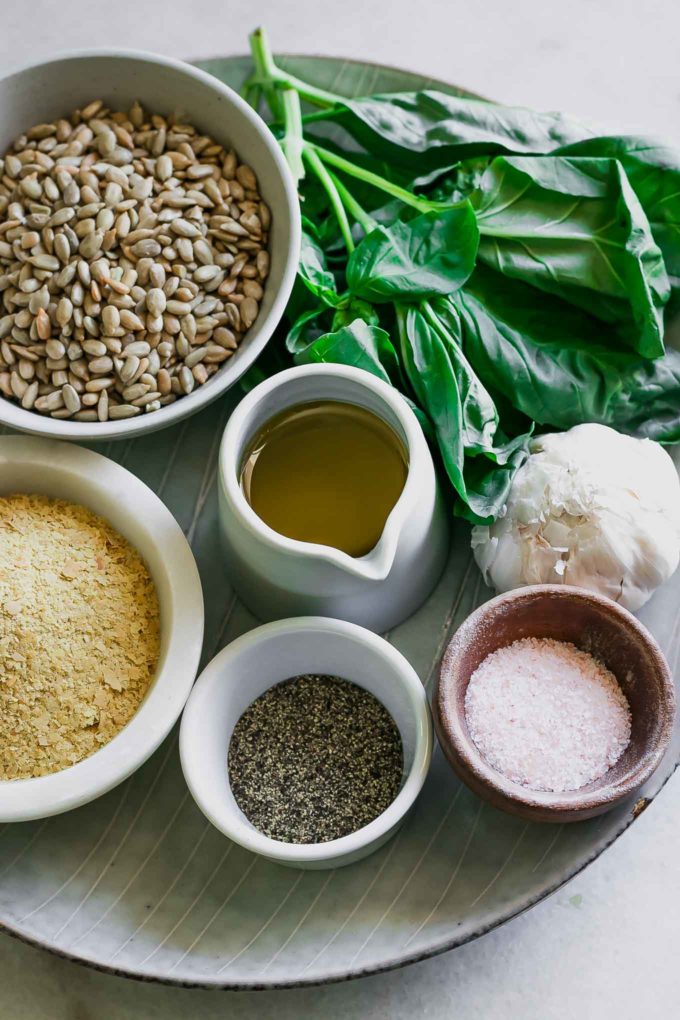
🥣 How To Make
1️⃣ Step One: Wash and prep the basil
First, wash basil by running it under cold water, gently loosening any dirt. Once clean, lay flat to dry or spin it in salad spinner.
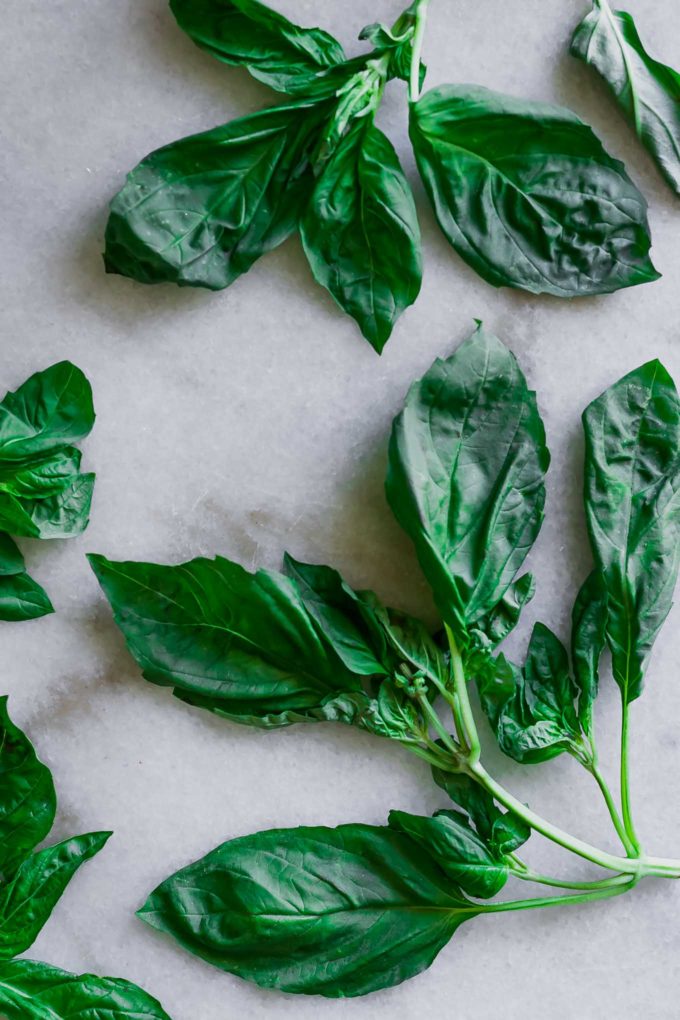
2️⃣ Step Two: Blend the greens, sunflower seeds, garlic, and oil
Once your basil has dried, add it to a food processor with the sunflower seeds and garlic, pulsing until it’s finely chopped.
Drizzle in olive oil until all ingredients are well coated and pesto is desired consistency.
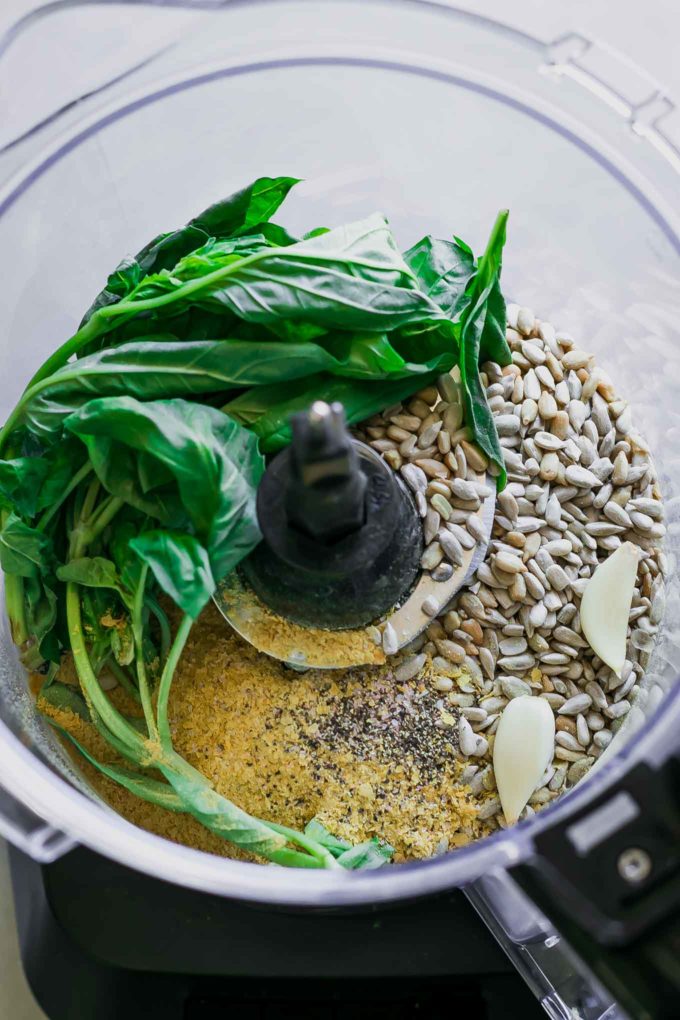
3️⃣ Step Three: Add nutritional yeast, spices, and lemon juice
Finally, the nutritional yeast, salt, and pepper should be slowly incorporated, adding more salt and pepper as needed. Pulse until well combined, then serving on top of pastas, soups, or vegetables.
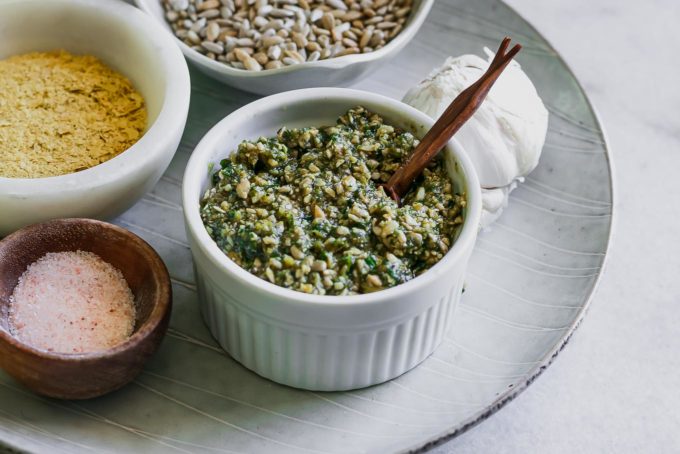
♻️ Storage + freezing
Pesto is versatile and can be used to quickly make a meal that we recommend doubling this recipe and storing some for later. Here’s how to store:
- Refrigerator: 1 week in a airtight container.
- Freezer: 4-6 months in a sealed freezer-safe container.
👉 Pesto pro tips: To keep pesto fresh, in order to minimize the browning of your pesto, add a layer of olive oil over top of your pesto prior to storing to reduce browning. To freeze, add pesto to ice cube trays, freeze, and transfer to a freezer-safe storage bag. Having small quantities on hand are prefect when you need a quick flavor enhancer!
🌱 Variations
There are other ways to make a vegan pesto free of the top 8 allergens! Below are a few ideas:
- Switch up the seeds: Use pepita, hemp, or watermelon seeds for a different crunchy base. Or use beans like white beans or garbanzo beans (try out chickpea-based pesto sauce!).
- Play with the greens: Consider arugula, carrot tops, beet leaves, or radish greens, or swap for herbs like parsley or cilantro.
- Do a combo: Switch it up by combining more than one green or seed in your pesto. Consider sunflower and hemp seed pesto or try basil and kale pesto.
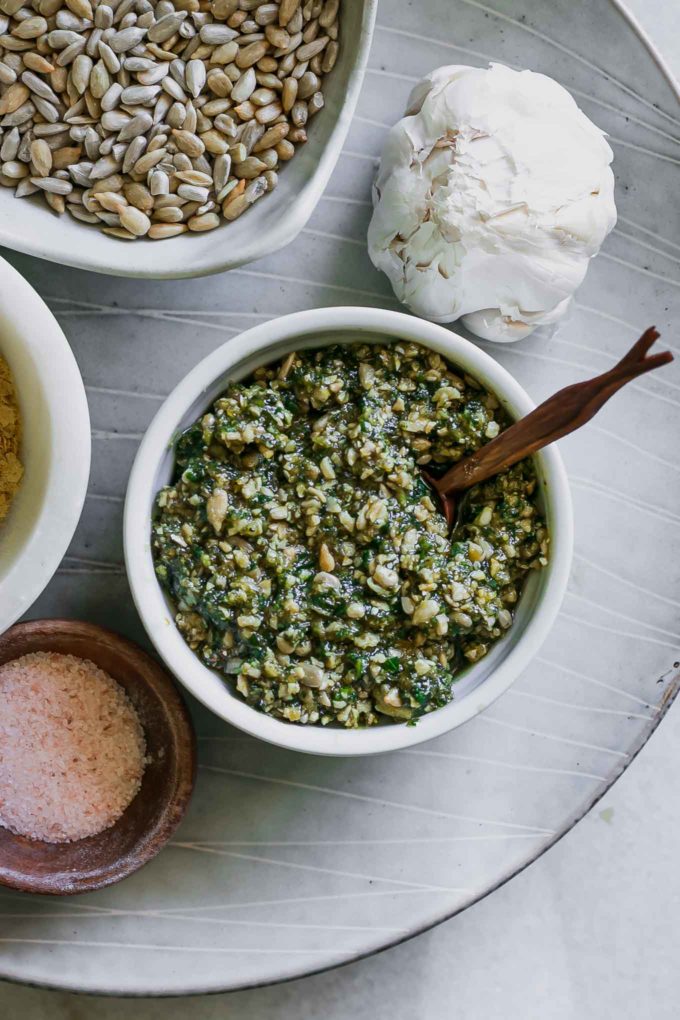
💚 More pesto recipes
We hope you enjoy making pesto — we love how quick, easy, and versatile it is! Check out our other nut-free pestos, like:
👉 Looking for more alternative pesto recipes? Try out Carrot Top Pesto, Beet Leaves Pesto, Radish Greens Pesto, or switch up the herbs and make a Parsley Pesto or a Cilantro Pesto. The pesto possibilities are endless!
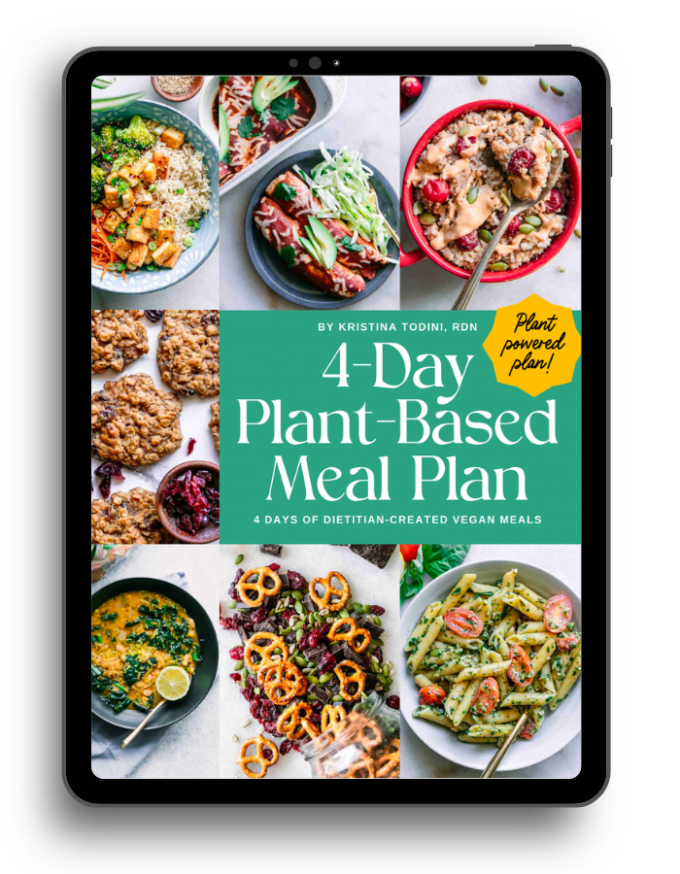
NOT SURE WHERE TO START WITH PLANT-BASED EATING?
Get my 4-Day Plant-Based Meal Plan to start your journey on the plant path.
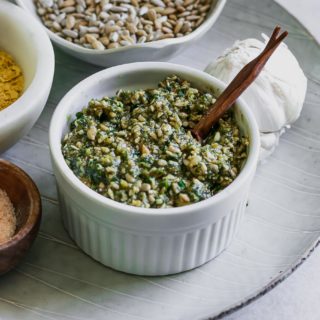
Sunflower Seed Pesto Sauce Recipe
Ingredients
- 2 cups basil
- ⅓ cup sunflower seeds
- 2 whole garlic cloves
- ½ cup 120 ml extra virgin olive oil
- ⅓ cup nutritional yeast or parmesan cheese
- ⅛ teaspoon salt
- ⅛ teaspoon fresh cracked pepper
- Optional: squeeze of fresh lemon juice
Instructions
- Wash and prep basil: Begin by rinsing the basil under cold water to remove any dirt. Once cleaned, dry it on a kitchen towel or in a salad spinner.
- Blend the ingredients: Next, add the cleaned and dried basil to a food processor. Add sunflower seeds and garlic cloves and pulse until finely chopped. As you're pulsing the ingredients, slowly pour in the in oil. You'll want your pesto to still have chunks for texture but all ingredients should be well coated in oil.
- Add spices to taste: Finally, slowly add in nutritional yeast, salt, and pepper, tasting and adding more until you reach your preferred taste.
Notes
- Make it vegan: Make this pesto recipe vegan by using dairy-free parmesan cheese or nutritional yeast.
- Tools needed: food processor or blender, knife set, cutting board
- Prep ahead: Make this simple pesto up to 2-3 days before serving, or freeze until ready to use.
- Leftovers and storage: Leftover pesto should be stored in an airtight container in the refrigerator for up to four days, and in the freezer for up to 2 months (possibly longer).
- Nutrition notes: This recipe made as written (with vegan cheese and seeds) is plant-based, gluten-free, and nut-free. It is a good source of vitamin C, plant-based protein, and fiber.
